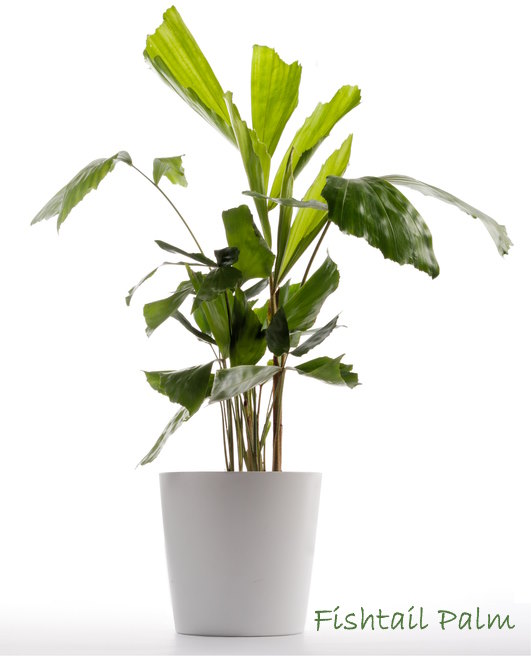Fishtail Palm Tree
Botanical Name: Caryota mitis
Fishtail palm tree gets its common name from the ragged-edged, ribbed texture of the dark-green leaflets that grow on upright stems. Its triangular leaflets are unique, and over time naturally split at the ends -- just like a fish tail.
 Unusual leaflets make Fishtail a captivating houseplant. Photo: ©Siwapot
Unusual leaflets make Fishtail a captivating houseplant. Photo: ©SiwapotGet to Know Fishtail Palm as a Houseplant
Caryota mitis grows in a clump, with several stems rising from its base that can easily be divided. It will eventually develop several fronds, 3 ft (90 cm) long. As this palm grows, the fronds will arch outward covered with large, wedge-shaped leaflets.
Native to Southeast Asia, Fishtail Palm thrives in warm temperatures and humidity. Despite its tropical beginnings, this palm is one of the easiest indoor palm plants to grow, requiring little care.
Grown as an indoor palm tree, it can reach about 6 ft (1.8 m) tall indoors, therefore it needs some vertical space. This palm becomes more lush and attractive as it matures; however, even small plants are attention-getting in any brightly lit room.
Fishtail Palm Problems, Solutions and Answers
To repot...or not? Repot only when roots grow out of the bottom of the drainage hole. Move it to a pot only 1-2 inches (2.5-5 cm) larger than the old one; this palm prefers to be slightly pot-bound. Crowded roots helps to limit this palm's size so it won't grow too large to keep indoors. Use a container with a drainage hole to prevent soggy potting medium, one thing this palm won't tolerate.
Brown leaf tips are likely caused by dry soil or more likely, dry air. Use any practical means to increase the humidity around this palm. A cool-mist room humidifier works best.
Wondering whether to prune? Do not prune palm trees unless an old branch dies. Palm trees grow from the tip of the branch. If you prune or pinch off the newest frond where it is attached to the stem, it will stop all new growth.
Dark brown or black spots on leaves are caused by a leafspot fungus. Cut off affected leaves. Place your palm where it'll get plenty of bright light and air circulation to prevent fungal diseases.
 Photo credit: vspn24 / istockphoto
Photo credit: vspn24 / istockphotoFishtail Palm Tree Care
Light: Give your palm bright, indirect sunlight during the growing season. You can move it outdoors for the summer, just keep it out of direct sun.
Water: Water thoroughly then allow soil to dry slightly between waterings. It is more tolerant of drier soil than wet. Water less in winter when growth has slowed. Use filtered or distilled water because tap water may contain fluoride, chlorine and other chemicals that can damage palms.
Humidity: Give this tropical native the humidity it craves. It's a good idea to use a humidity gauge near your palm, rather than guess. Indoor air can become extremely dry, especially during the winter months. If relative humidity drops below 50%, stand the pot on a humidity tray or use a cool-mist room humidifier.
Temperature: Average to warm temperatures, preferably 65°F/18°C at night and up to 85°F/29°C during the day. Palms don't like the cold. Protect your plant from cold drafts near doorways and AC vents.
Soil: All-purpose, good-quality potting mix. Add a little sand to the potting soil to speed up drainage. Use a ratio of 3:1 potting mix to sand. Use horticultural sand, not the type from the beach, which contains salts and impurities that can damage palms.
Fertilizer: Feed once in early summer with a slow-release fertilizer.
Propagation: Sow seeds in spring or summer in fresh potting medium. Don't bury them -- palm seeds germinate best when they are barely covered. Keep them warm and moist. Use a seedling heat mat, if needed to maintain a minimum 70°F/21°C while seedlings sprout. Offsets can be carefully cut away from the plant and potted in separate containers.


